Article from Kern Precision Inc.
Exclusive watches - “made in Australia?” Absolutely, thanks to Nicholas Hacko, a talented watchmaker who opened a small factory making high-quality timepieces in Sydney a few years ago. To be flexible and competitive, he invested in a high-precision 5-axis machining center from Kern Microtechnik, enabling him to reliably produce the micron-accurate parts, which are the basis for his business today.
Originally from Europe, the Hacko family has a long tradition of watchmaking. In 1992, when Nicholas Hacko emigrated to Australia, he already was in the third generation of his family who all succeeded in the watchmaking industry.

NH Watches has been designing and producing its own watches since 2016—watches made in Australia. Photos courtesy of Kern Precision
In 2011, Hacko took his first step towards making his own watches by founding his own small business called “Nicholas Hacko Watchmaker” – in short NH Watches. Initially, he repaired watches and manufactured replacement parts. Inspired and motivated by the high precision of traditional watch manufacturers and by using his expertise in high-quality workmanship and flawless assembly, five years later Hacko created his first entirely self-designed and developed watch.
Since then, the Australian has been living his dream and enjoying significant commercial success. He produces exclusive, unique timepieces in the price range from USD $1,200 to $11,000. As Hacko explains, he has already surpassed his original goal of making 100 watches per year: “Thanks to a long waiting list of enquiries from interested parties, we have already sold more than 600 watches after only three years. And the huge demand from Australia, Europe and Asia is still going up.”
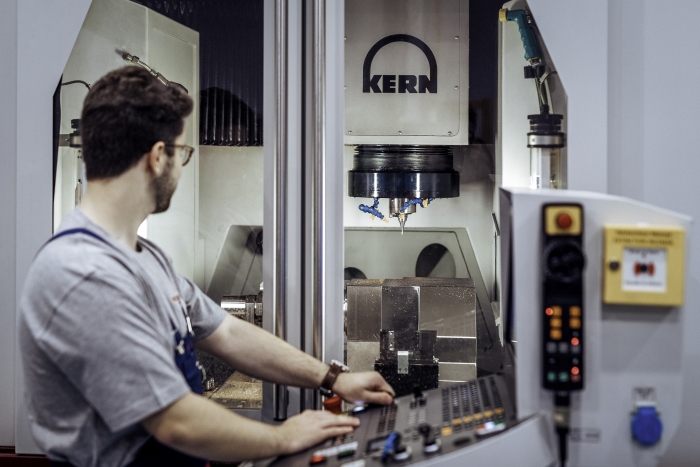
In 2017, Nicholas Hacko invested in a used Kern Pyramid Nano: “This 5-axis machining center still has the same tremendous precision as it did at the beginning of its life. It produces each part exactly the way we program it—faultless.”
Producing microparts with μm precision
Besides its founder's creativity and entrepreneurial spirit, Hacko believes that two additional factors are crucial for the success of the brand. First of all, of course, his employees, seven highly motivated people and three of them are apprentices learning the watchmaker’s trade. And then he underlines the importance of his equipment and introduces the Kern Pyramid Nano, a high-precision 5-axis machining center he has been using since 2017. “This machine mills very small gears, bridges, pallets, mainplates and other micro parts with greater precision than is actually necessary,” Hacko said.
Or, to put this into numbers: Hacko typically needs a production accuracy of between 6 µm and 10 µm to ensure his watches keep perfect time throughout their life. In exceptional cases, XY pitch accuracy of just +/-2 μm must be met when drilling and interpolating holes in metal plates. The Kern Pyramid Nano, developed for ultraprecise production by Kern Microtechnik GmbH, Eschenlohe, Germany, reliably achieves a machining accuracy of less than 1 μm—throughout the entire service life of the machine.
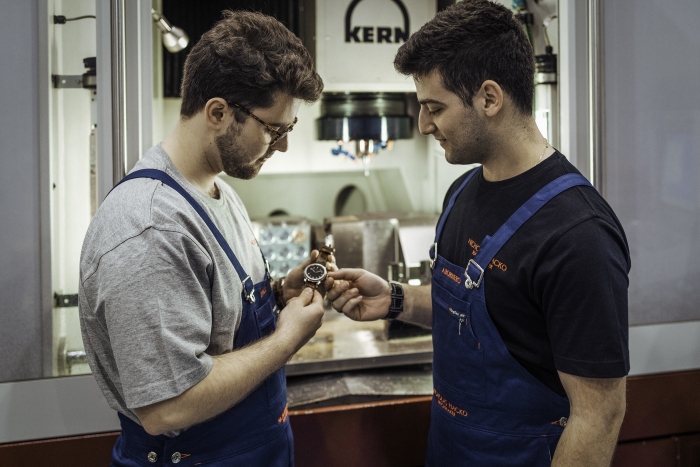
NH Watchmaker reliably produces micron-accurate parts using the Pyramid Nano.
This outstanding level of performance is the result of numerous technical refinements that were incorporated into the machining center’s development. While Matthias Fritz, head of development at Kern, is not prepared to reveal all of the Pyramid Nano's secrets, he is happy to name a few key factors: “We've equipped the Kern Pyramid Nano with complex, hydrostatic guides and drives that are not subject to any mechanical wear. In addition, our hydrostatics dampen any vibrations, so even high rates of acceleration have no effect on the machining accuracy.” The result is a machining center in which productivity and precision go hand in hand.
This is just one of the reasons why Kern machining centers are in widespread use throughout the watchmaking industry—the Australian watchmaker had long had his eye on a machine made by the Bavarian precision experts. At the AMB trade fair in 2016 in Stuttgart, Germany, he saw a Kern machine in action for the first time, which only confirmed his opinion: “I was convinced that a machining center of this type would be ideal for my needs.”
Udo Reinwald, Kern sales director Asia, invited NH Watches to Germany in February 2017 to discuss some options at the company’s machine engineering factory in Eschenlohe, including the possibility of purchasing a used machine. The result was that Hacko found what he was looking for. In the summer of 2017, when a Swiss luxury watch company replaced a Kern Pyramid Nano with a new Kern milling center, Hacko immediately decided to buy the used machine.
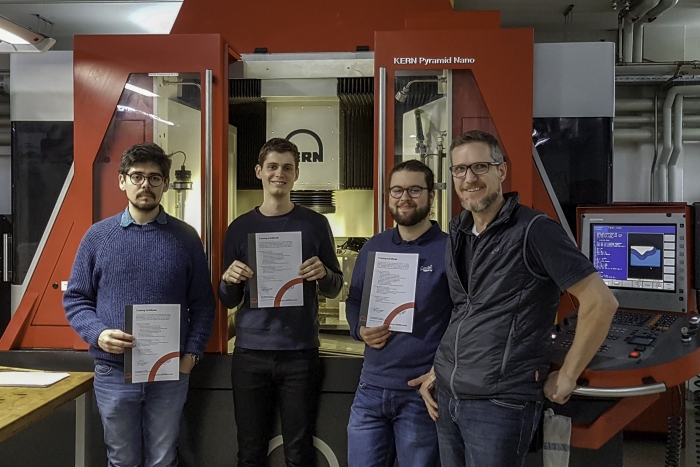
During a training course in Eschenlohe, Germany, a small team from NH Watches learned how to operate the Kern Pyramid Nano. From left to right: Christopher Soto, Tyler Hailwood and Josh Hacko with Kern TC-leader Thomas Mauer.
A used Kern machine with flawless precision
After inspection and maintenance by the Kern service department, the transaction was soon completed—Hacko can now personally confirm Kern's claim that the machine's performance and precision remain unchanged throughout its service life. “It's just like my watches,” he beams, before expressing his satisfaction with the usability of his 5-axis milling center: “We took a small team from our company to Eschenlohe, Germany, where we received excellent training in the Kern Training Center.”
During their visit, the Australians learned all the skills needed to reliably produce high-quality parts, including programming with Heidenhain conversational code, using the right tools and setting up the milling center.
The machine’s final adjustments and commissioning in Sydney also went very smooth. With on-site support from a Kern service technician, it was ready for use in early March 2018. It has been running with the help of Kern’s teleservice support ever since and “produces each part exactly as we program it. It simply doesn’t make any mistakes,” says Nicholas.
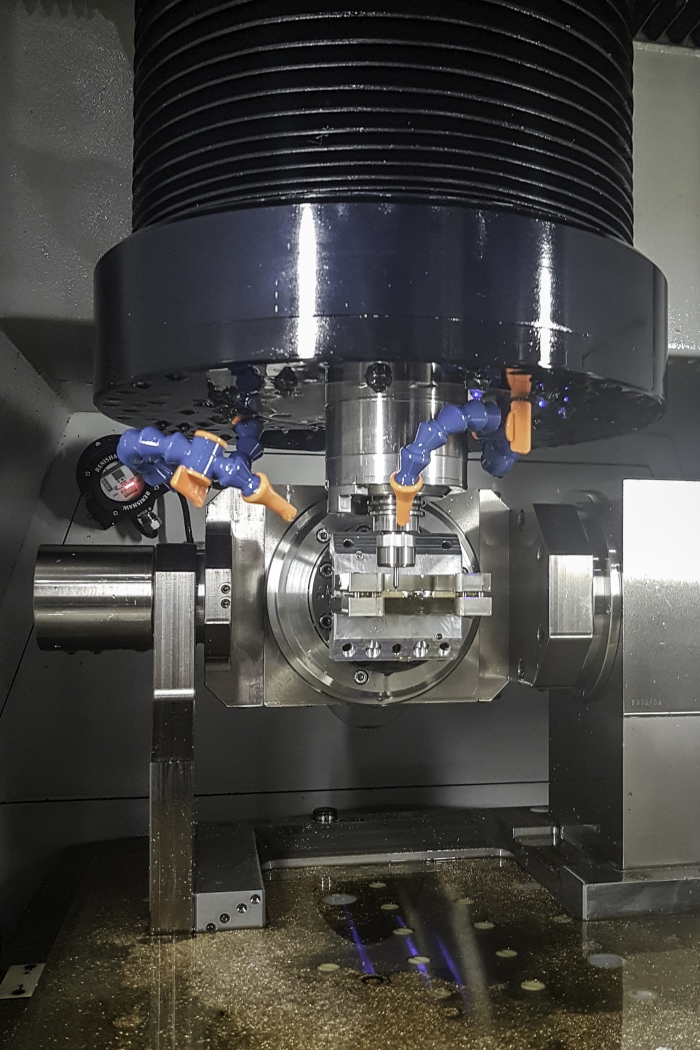
If required, the 5-axis machining center can mill parts with sub-1-μm precision.
Thanks to its investment in the Kern machine, NH Watches can now serve its customers much faster and further increase its sales. In the past, the company had no choice but to purchase the required small parts externally and, being a minor customer, was not always high on the supplier's priority list. In addition, because the plates, gears and other parts required by NH Watches were primarily produced overseas, the parts deliveries were sometimes subject to unforeseeable delays. Interesting side effect: The raw materials used to produce these parts, such as brass in the mainplates and bridges were originally mined and exported from Australia to Korea. They were machined in Korea and were reimported back to Australia as processed bar material. A logistical odyssey that is no longer needed.
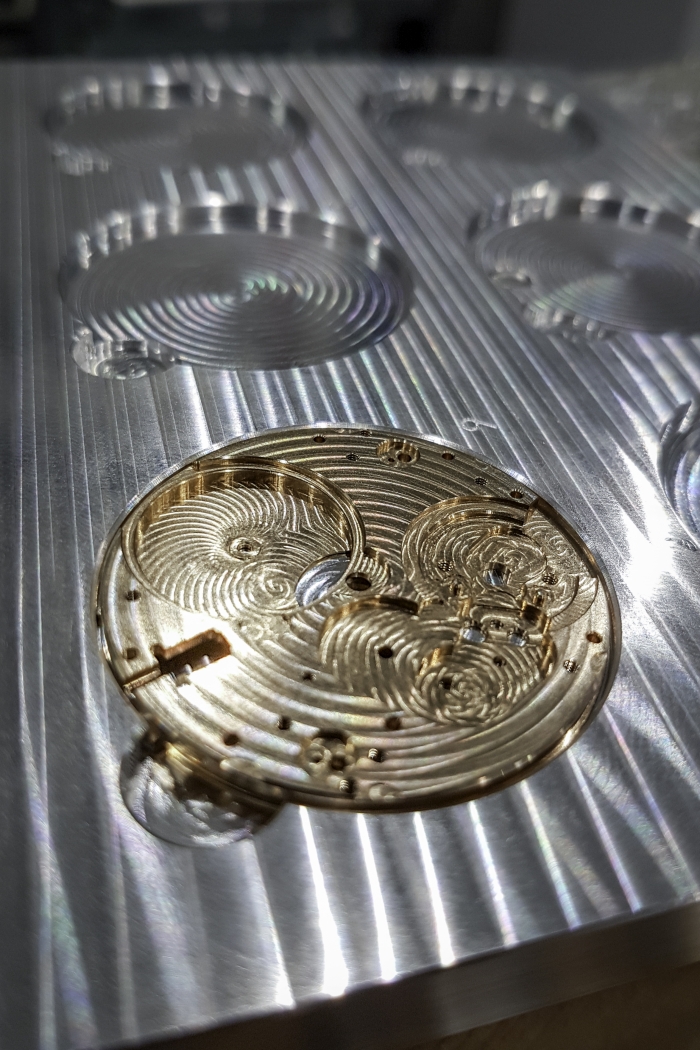
High-precision microparts, such as these boards and gears, ensure that the watches stay tuned.
Contract manufacturing as a new business area
Recently, NH Watches has found another way to utilize its new production capacity—as a contract manufacturer for industrial companies that need highly precision parts. With no significant competition for this service in Australia, Hacko is now expanding his business and already supplies several companies in the medical and moldmaking industries. He sees significant potential for the future in this area.
“It's a great feeling to be the only entrepreneur in Australia with a high-precision machining center of this type," Hacko said. "I'm sure this gives us a lot of growth potential and I'm looking forward to being able to buy more Kern machines in the future.”
Related Glossary Terms
- centers
centers
Cone-shaped pins that support a workpiece by one or two ends during machining. The centers fit into holes drilled in the workpiece ends. Centers that turn with the workpiece are called “live” centers; those that do not are called “dead” centers.
- gang cutting ( milling)
gang cutting ( milling)
Machining with several cutters mounted on a single arbor, generally for simultaneous cutting.
- machining center
machining center
CNC machine tool capable of drilling, reaming, tapping, milling and boring. Normally comes with an automatic toolchanger. See automatic toolchanger.
- milling
milling
Machining operation in which metal or other material is removed by applying power to a rotating cutter. In vertical milling, the cutting tool is mounted vertically on the spindle. In horizontal milling, the cutting tool is mounted horizontally, either directly on the spindle or on an arbor. Horizontal milling is further broken down into conventional milling, where the cutter rotates opposite the direction of feed, or “up” into the workpiece; and climb milling, where the cutter rotates in the direction of feed, or “down” into the workpiece. Milling operations include plane or surface milling, endmilling, facemilling, angle milling, form milling and profiling.
- milling machine ( mill)
milling machine ( mill)
Runs endmills and arbor-mounted milling cutters. Features include a head with a spindle that drives the cutters; a column, knee and table that provide motion in the three Cartesian axes; and a base that supports the components and houses the cutting-fluid pump and reservoir. The work is mounted on the table and fed into the rotating cutter or endmill to accomplish the milling steps; vertical milling machines also feed endmills into the work by means of a spindle-mounted quill. Models range from small manual machines to big bed-type and duplex mills. All take one of three basic forms: vertical, horizontal or convertible horizontal/vertical. Vertical machines may be knee-type (the table is mounted on a knee that can be elevated) or bed-type (the table is securely supported and only moves horizontally). In general, horizontal machines are bigger and more powerful, while vertical machines are lighter but more versatile and easier to set up and operate.
- pitch
pitch
1. On a saw blade, the number of teeth per inch. 2. In threading, the number of threads per inch.
- sawing machine ( saw)
sawing machine ( saw)
Machine designed to use a serrated-tooth blade to cut metal or other material. Comes in a wide variety of styles but takes one of four basic forms: hacksaw (a simple, rugged machine that uses a reciprocating motion to part metal or other material); cold or circular saw (powers a circular blade that cuts structural materials); bandsaw (runs an endless band; the two basic types are cutoff and contour band machines, which cut intricate contours and shapes); and abrasive cutoff saw (similar in appearance to the cold saw, but uses an abrasive disc that rotates at high speeds rather than a blade with serrated teeth).
